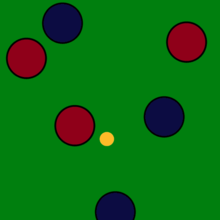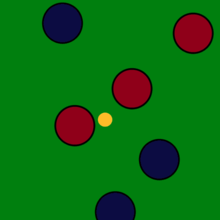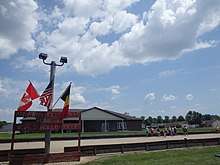Rolle Bolle
Rolle Bolle (/ˈroʊliˈboʊli/ ROH-lee-BOH-lee)[1][2] also known as Belgian Bowling, or Krulbollen in Belgium,[3] is a bowling sport related to boules, which originates from the Flanders region of Belgium. The sport was introduced to North America in the late 19th and early 20th centuries and is played in some rural areas of the Midwest and Prairie regions of the United States and Canada.[4]
 A Rolle Bolle player bowls the bolle towards the stake at the other end of the court | |
| Characteristics | |
|---|---|
| Contact | Non-contact |
| Team members | 3-4 players |
| Type | Bowling, boules |
| Equipment | Bolles (balls) and stakes |
| Presence | |
| Olympic | No |
One of the defining characteristics of Rolle Bolle is the wheel-like shape of the ball, or bolle. Bolles are manufactured in a way so that they do not roll straight but in a curved, elliptical path.
History
The exact origins of Rolle Bolle are unknown, but it is known that it was developed in Flanders, a Dutch speaking region of Belgium, before the 20th century.
The Dutch name for Rolle Bolle, krulbollen, literally translates to "curve ball" due to the elliptical path taken by the bolle.
In the late 19th and early 20th centuries, Belgian and Dutch immigrants to the United States and Canada introduced Rolle Bolle (krulbollen) and other similar Belgian sports such as feather bowling (trabollen).[5][6]
Rules and play
Rolle Bolle is played on a flat court typically made of natural soil, crushed limestone, or pavement. Two stakes (or "pegs")[2] are placed a distance apart on either ends of the court, typically 30 feet (9.1 m). Courts are typically 12 feet (3.7 m) wide.[7] Stakes can be between 1 to 3 inches (2.5 to 7.6 cm) in diameter and are made of wood (such as a baseball bat pounded into the ground),[1] but other materials are also used.
The balls, or bolles, are typically 6 to 8 inches (15 to 20 cm) in diameter and 4 inches (10 cm) thick.[8] Traditional bolles are made of wood, however other materials can be used such as hardened rubber or molded plastic. Bolles are machined with a taper, which causes them to roll in an elliptical fashion.
Rolle Bolle is played by two teams of 3-4 players each. Games are broken up by rounds; each round is an opportunity for a single team to score points. In a round, players from opposing teams take turns rolling their bolle towards the stake at the far end of the court. At the end of each round, when all players have rolled their bolles, points are awarded to the team with the closest bolle(s) to the stake. The next round then begins in the same manner, aiming for the other stake. The first team to score a set number of points (typically 8) is the winner.
Scoring


A round is complete when both teams have played all of their bolles. If the round finishes then the team with the closest bolle wins the round and scores one point for each of its bolles that is closer to the jack than other team's closest bolle. The first team to a predetermined number of points is the winner of the game.
Strategy
When rolling a bolle, there are two main strategies a player can choose between: bowling, and shooting. When bowling, the player (bowler) aims the bolle along an elliptical course to get as close to the stake as possible. The bowler releases the bolle underhand, with not much speed. This strategy is used for good placement for scoring. The alternative option is to shoot. When shooting, the player (shooter) aims the bolle in a straight line, directly at an opponent's bolle nearby the stake. The bolle is released underhand, but with great speed. The goal is to knock the opponents' bolle(s) away from the stake.[9]
Geographical Distribution

In Europe, Rolle Bolle is played in the Flanders regions of the Netherlands and Belgium, where it originated. It is more common in rural areas, especially near Ghent, in the Meetjesland region and the region from Knesselare to Bruges.
In North America, Rolle Bolle is played in rural areas ranging from Iowa to Winnipeg, in towns settled by Belgian emigrants. States and provinces where Rolle Bolle is played include: Illinois, Iowa, Manitoba, Minnesota, and Wisconsin.[5][8][10]
See also
- Feather Bowling, which uses a similar bolle but the court is a trough.
References
- "BOWLING? HORSESHOES? NO, ROLLE BOLLE". Chicago Tribune. Tribune Publishing. Retrieved 17 May 2020.
- "BEST VIDEOGRAPHY ROLLE BOLLE". KWQC-TV. NBC. Retrieved 17 May 2020.
- https://www.vlas.be/vlaspdf/infofolders/krulbol.pdf
- https://www.rollebolle.org/
- "2016 INTERNATIONAL ROLLE BOLLE TOURNAMENT". Retrieved 17 May 2020.
- "Weave, Wobble and Roll: Feather Bowling". Smithsonian Magazine. Smithsonian Institution. Retrieved 17 May 2020.
- https://www.rollebolle.org/the-rules/
- "Rolle Bolle has a little something for everyone". Quad-City Times. Lee Enterprises. Retrieved 17 May 2020.
- https://www.vlas.be/vlaspdf/infofolders/krulbol.pdf
- "Belgian Bowling on a Tuesday Night". Shaw TV. Shaw Communications. Retrieved 17 May 2020.